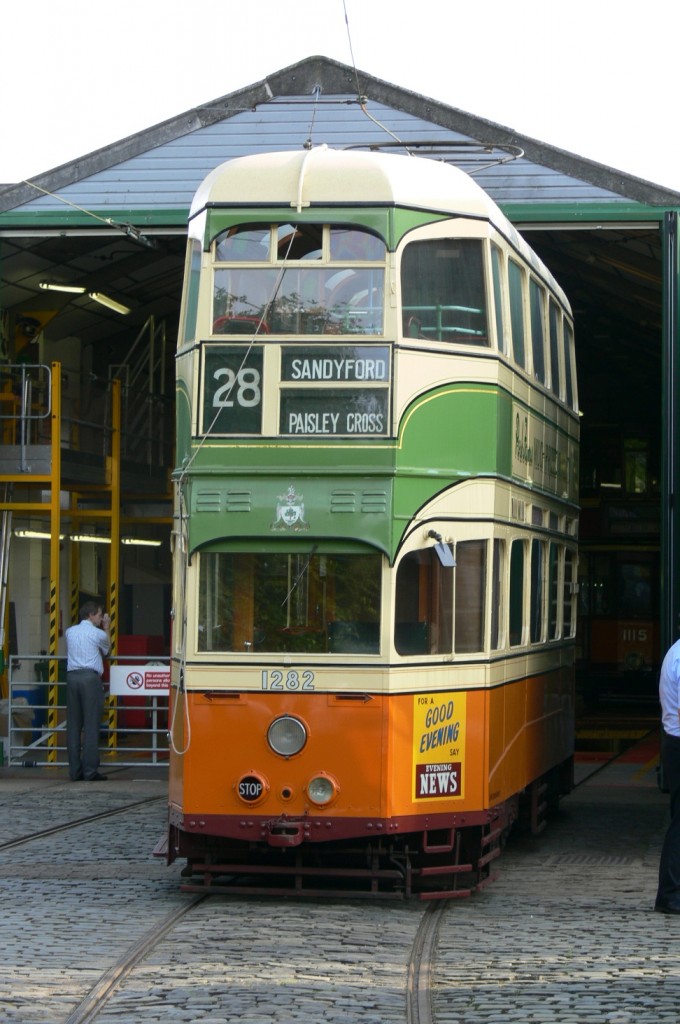The recent inclusion of Glasgow ‘Coronation’ 1282 during the celebration of 50 years since the last tram operated in Glasgow has been a very memorable occasion, when it was possible to experience this wonderful tram by taking a ride along the Crich Tramway. The occasion has raised hope that it will not be too long before the tramcar is once again part of the operational fleet, on a more long-term basis. The following report is provided by John Henderson, with our grateful thanks, to highlight the likely extent of such a project.
This prospect has been highlighted by the book that Wim Beukenkamp published recording a brief history of the Coronations, and specifically 1282. His initiative was a personal mission, and it has raised much renewed interest in this special tramcar. It appears however, that the extent of work required to return the tram to full operation has been overestimated. The record of the seventies’ Crich restoration has now been clarified by John Henderson who throughout the restoration, was a key person responsible for the actual work undertaken. He has put the record straight regarding each area of work undertaken, and puts a different perspective on what is required. A major amount of work should only require maintenance level restoration, whilst it is accepted that mechanical and electric systems will certainly need significant work after its years of Crich useage.
It is acknowledged that the work required will still be expensive, but should be nowhere near the implied costs recorded within the booklet. Removing any tramcar emotion, the previous restoration was extremely thorough costing the museum a great deal of money, and the work was completed through government grant subsidies to cover skilled wage costs. The past investment, just like any other thoroughly restored tram, should justify further expenditure to maintain prior restoration. In the present day for this to occur, it will need support through substantial donations; Wim’s book, it is hoped, will have started this campaign.
A summary of the work undertaken on Glasgow 1282 at Crich during the 1970s, in response to the tasks listed in Wim’s book, is republished below with his permission:
-
Dismantling the tram to its bare frame and components – This was undertaken to an extent not undertaken at Crich before, and included the upper deck being suspended whilst the lower framework was restored/replaced where necessary and all work thoroughly checked.
-
Repairing the bogies possibly including fitting new tyres – The detail work will need further examination and possibly much work. However at the time crack testing was undertaken and any remedial action again was supervised by John Shawcross.
-
Repairing and renewing the underframe – This is exactly what took place, however the underframe received surface protection to a high standard so it would be somewhat surprising if major work was required now.
-
Repairing the body pillars – This took place, and most timber sections were renewed with teak as per original. Where new metal was required, it was replaced, and again surface protection exceeded original.
-
Overhaul the air brake equipment – Most air piping was renewed, but will probably require re-servicing.
-
Overhauling the remote control equipment – Was totally overhauled, but no doubt will need further attention.
-
Overhauling the four motors – Accepted, but at restoration they were overhauled and received all new bearings.
-
Renewing the cabling – The tram received a complete rewire covering traction, lighting and bells.
-
Repairing the upholstery of the seats – Accepted, but mostly were reupholstered where required; suggest same done again.
-
Renewing most of the panelling – All panels were replaced except the dash panels, and the windscreen hoods, so I see no reason for this unnecessary job. All window pans were found to be in excellent condition, but during restoration received much more aluminium surface protection and sealing. All window seals were replaced with new along with much glass with laminated type.
-
Repairing the floors both downstairs and upstairs – The lower deck floor was totally renewed and all upper deck floor replaced around the edging where the top deck is affixed. Brand new cork flooring was fitted to the lower deck and areas replaced upstairs following main flooring replacement. All lower deck hatches were renewed.
-
Repairing the roof – This was stripped of original canvass and found that all timbers and boarding were in first class condition so no replacement was necessary. The roof was recanvassed correctly including white lead for all base paint stages, followed by resin based coatings. Roof lights were removed and rebedded.
-
Repainting the car – The paintwork for this type of structure has lasted extremely well for the time since restoration and accept repaiting is required.
-
And many, many other small jobs – No doubt there will be many, however surely this is not a major part of restoration now.


Agreed – it is highly desirable that this example of perhaps the finest British tram class should be restored to, and maintained in, full working condition – maybe in time for its 75th anniversary in 3 years’ time. How about an appeal?
Let’s not forget about Glasgow 1297 either.